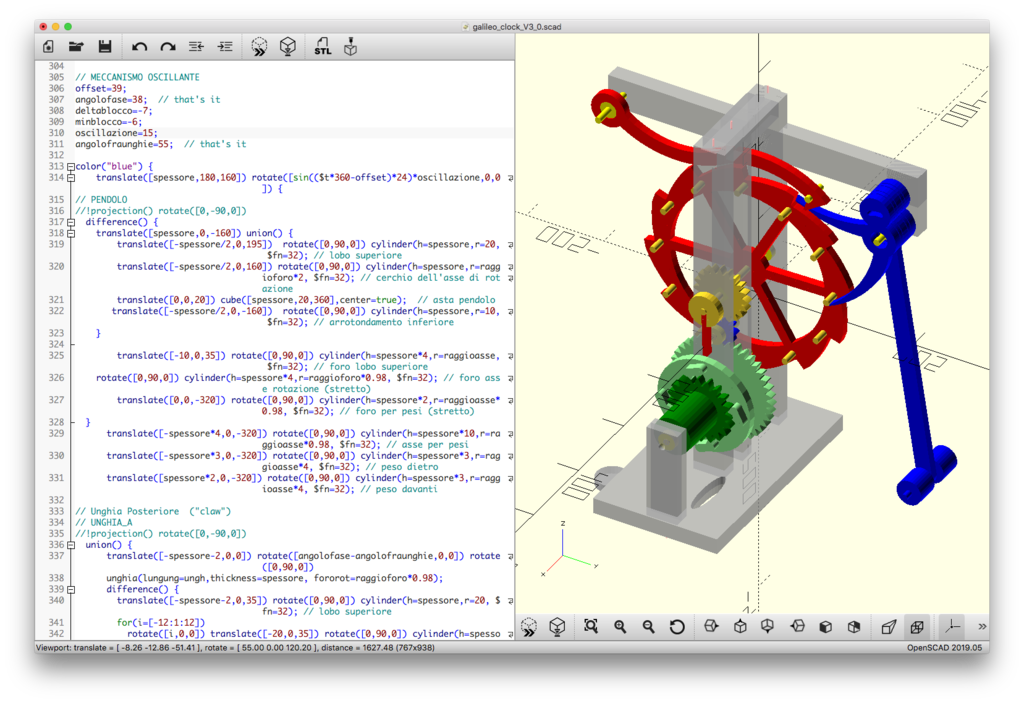
Galileo Clock
thingiverse
This is the design (made with OpenSCAD and fully customisable) of a functioning mechanical clock following the original ideas of Galileo Galilei dating back to 1600, that can be made on a laser cutter (with the addiction of standard bearings and a few other simple parts). The oscillating mechanism uses a clever escapement system attributed to Galileo himself and also the first application of a pendulum to a clock (Galileo was the first to observe the isochronism of the pendulum, in 1602!) The design has been modelled with OpenSCAD (sources included: two files form the BOSL library are also needed and are included here, just create a folder named "BOSL" and move them inside: constants.scad and involute_gears.scad), it can be animated to show the movements of all parts, and it is fully customisable. Generation of the DXF vector files is easily achieved by uncommenting the "projection" lines and then select "2D export as dxf" within OpenSCAD. This model is part of an effort, promoted by the "Associazione Amici dell'Orologeria Pesarina Giovanni Battista e Remigio Solari", to teach the basics of the ancient clockmaking traditions of Val Pesarina (Pesariis, Friuli Venezia Giulia region, Italy) to the students of high schools and technical schools in Italy. The model mechanics are based on the original drawings by Galileo Galilei and on many other modern renderings and reconstructions found on the Internet (see source code for links), and have been re-designed in OpenSCAD by Carlo Fonda with contributions from Alberto Tonelli and Stefano Solari. The design and the laser-cut prototype (all pieces are made from 10mm plywood, 608 bearings and wooden axes of 8mm diameter) has been done at the Scientific Fablab of the ICTP (The Abdus Salam International centre for Theoretical Physics) based in Trieste, Italy. List of 2D vector files and number of pieces needed (from 10 mm plywood): BASE_A.dxf BASE_B.dxf BLOCCO.dxf BOCCOLA_Z20.dxf BOCCOLA_Z40.dxf CARICA_1.dxf CARICA_2.dxf CARICA_3_x6.dxf (six copies) Galileo_Clock_2.1.dxf Galileo_Clock_2.1.pdf Galileo_Clock_2.1.svg GEAR_Z10.dxf GEAR_Z20.dxf GEAR_Z40.dxf NOTTOLINO_x4.dxf (four copies) ORIZZ_x2.dxf (two copies) PENDOLO.dxf PLINTO_1A.dxf PLINTO_1B.dxf PLINTO_2A.dxf PLINTO_2B.dxf PLINTO_3A.dxf PLINTO_3B.dxf PLINTO_4A.dxf PLINTO_4B.dxf RANELLA_x2.dxf (two copies) RUOTA_GALILEO.dxf SECONDI.dxf UNGHIA_A.dxf UNGHIA_B.dxf List of axes length (diameter = 8mm): 165mm lower axe 60mm middle axe 160mm higher axe 70mm (2 pieces, axes for the blocking mechanism and for the pendulum) 30mm (12 pieces, pins for the wheel) Other materials: - 11 bearings of type 608 (ID 8mm, OD 22mm) - screws and glue for wood - 2 rubber bands for the charge mechanism - metal washers as weights for the pendulum - rope and heavy weight for the charge mechanism
With this file you will be able to print Galileo Clock with your 3D printer. Click on the button and save the file on your computer to work, edit or customize your design. You can also find more 3D designs for printers on Galileo Clock.
